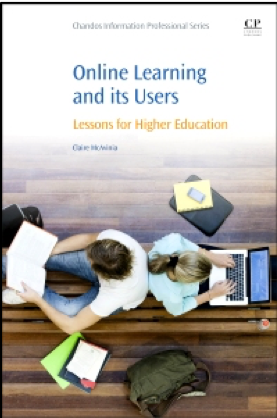Publication Details
| OLOR Series: | ROLE Reviews |
| Author(s): | Joni Boone |
| Original Publication Date: | 15 March 2018 |
| Permalink: |
<gsole.org/olor/rolereviews/2018vol1no1.rev7> |
Publication Note
This review was originally published in Research in Online Literacy, vol. 1, no. 1 (2018).
Resource Overview
Media, Figures, Tables |
Resource Contents
Review of Online Learning and Its Users
Virtual learning has a varied history in campus-based higher education institutions with many proponents and naysayers. As with any program or initiative in higher education, virtual learning in the form of Learning Management Systems (LMS)/Virtual Learning Environments (VLEs) must be examined carefully by administrators, learning technologists, educators, and others to determine the potential impact on student learning and success. In Online Learning and Its Users: Lessons for Higher Education (2016), Claire McAvinia, a Learning Development Officer at the Learning, Teaching and Technology Centre in the Dublin Institute of Technology, explores the impact of online learning by focusing specifically on VLEs in campus-based institutions through a study involving language learning classes in eight institutions in Ireland. Using activity theory, McAvinia shares the perspectives of managers, e-learning support services, instructors, and learners and offers hope beyond the sequence of buildup, disappointment, and discard familiar to many technological trends in education.
McAvinia’s book begins with a general history of online learning in higher education from the 1980s to the present, weaving in the technological trends as well as the social and economic climates that help to influence policy. In chapter 2 “Challenges and Disappointments,” she reveals causes for the “literature of disappointment in e-learning research” (p. 51) that many academics are familiar with and perhaps influenced by. This framework allows readers to understand past conflicts with learning technology and begin to explore different, and perhaps more pertinent, questions related to the place of and use of technology in education.
Once this foundation is set, McAvinia uses activity theory to explore the results of her study of VLEs in campus-based higher education institutions, then takes the exploration in theory beyond VLEs to Massive Open Online Courses (MOOCs). By intricately examining the subjects, objects, rules, tools, division of labor, and eventually, the outcome of activities within VLEs, McAvinia helps readers understand the benefits and drawbacks of these technologies within institutions. For instance, is using a VLE as a repository of resources limiting, or does this use potentially encourage more engaging, constructivist approaches, such as flipped classrooms? She also helps readers recognize the inconsistencies among different stakeholders – management, technologists, instructors, and learners. McAvinia ultimately projects a hopeful perspective of the future of technology in higher education, encouraging all to perhaps consider the benefits of these technologies by asking new questions, altering expectations, and examining impacts globally.
Though McAvinia does acknowledge the limitations of her study and encourages more institutional-wide research on the topic, this book effectively examines the disenchantment many in higher education have with online technology and posits a way out of this negative cycle. The associated activity theory diagrams within the book can be quite complex and explanations are at times a bit repetitive; however, the methodical examination of each aspect of the VLE implementation through activity theory helps readers clearly see the expectations, possibilities, and contradictions present. This approach may help all involved ask more relevant questions, leading to more positive outcomes for their institutions’ futures with technology.
About the Reviewer
Joni Boone has a master's degree in English and has taught and tutored composition for 15 years. For the past 4 years, she has been a faculty developer at an online university. Her research interests include multimedia feedback, plagiarism trends and prevention, and personality type in organizations and education.



